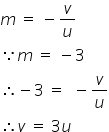Class 9 SELINA Solutions Physics Chapter 7: Reflection of Light
Reflection of Light Exercise Ex 7(A)
Solution A.1
(c) incidence, normal
Solution A.2
(c) plane of incidence
Solution A.3
(d) Both (a) and (b)
Solution A.4
(d) i = r
Solution A.5
(d) 0°
Solution A.6
(b) 0°
Solution A.7
(a) normal
Solution A.8
(c) real
Solution A.9
(d) Erect and of same size
Solution A.10
(c) virtual with lateral inversion
Solution A.11
(d) real, virtual
Solution A.12
(b) M, T, V
Solution A.13
(a) d
Solution B.1
Luminous objects, as we know, are those that emit light on their own.
As a result of their high temperatures, the Sun and fire emit light, while the Moon and Earth reflect it. A shooting star is a meteoroid that burns up while entering in Earth's atmosphere.
Solution B.2
The return of light into the same medium after striking a surface is called reflection.
Solution B.3
Black silvered surface reflects most of the light incident on it.
Solution B.4
(a) 0o
(b) Same as the incident ray
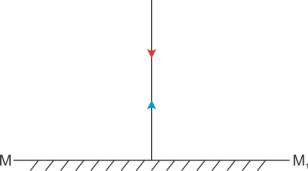
Solution B.5
As we know according to law of reflection.
∠i = ∠r
∴ sin i = sin r
i.e., ![]()
Solution B.6
Black polished mica sheet.
Solution B.7
If a light ray strikes a mirror and retraces its path, then both the angle of incidence and the angle of reflection are 0°.
i.e., ∠i = ∠r = 0°
Solution C.1
(a) Plane mirror: Plane mirror is a highly polished and smooth reflecting surface made from a clear plane glass sheet, usually thin and silvered with suitable reflecting abrasive (for example, mercury) on one side. Once this pasting is done, then the glass becomes opaque but due to the reflecting property of the abrasive, the plane glass sheet becomes a plane glass reflector or a plane glass mirror.
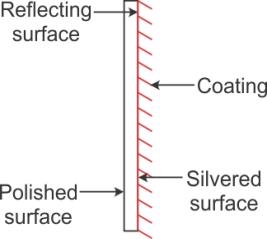
(b) Incident ray: The light ray striking a reflecting surface is called the incident ray.
(c) Reflected ray: The light ray obtained after reflection from the surface, in the same medium in which the incident ray is travelling, is called the reflected ray.
(d) Angle of incidence: The angle which the incident ray makes with the normal at the point of incidence is called the angle of incidence. It is denoted by the letter i.
(e) Angle of reflection: The angle which the reflected ray makes with the normal at the point of incidence is called the angle of reflection. It is denoted by the letter r.
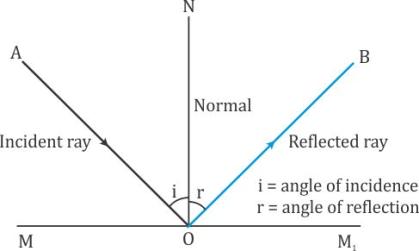
Solution C.2
Reflection of light from a plane mirror is regular reflection and reflection of light from plane sheet of paper is irregular reflection of light.
Solution C.3
Laws of reflection:
1. The angle of incidence is equal to the angle of reflection.
2. The incident ray, the reflected ray and the normal at the point of incidence, lie in the same plane.
Solution C.4

Solution C.4
(a) Three characteristics of image formed by plane mirror:
(i) Image formed in erect (upright)
(ii) Image formed is virtual
(iii) Image formed is of the same size as the object
(b) The image is situated at the same perpendicular distance behind the mirror as the object in front of it.
Solution C.5
|
Real Image |
Virtual image |
|
1. A real image is formed due to actual intersection of the reflected rays. |
1. A virtual image is formed when the reflected rays meet if they are produced backwards. |
|
2. A real image can be obtained on a screen. |
2. A virtual image cannot be obtained on a screen. |
|
3. A real image is inverted with respect to the object. |
3. A virtual image is erect with respect to the object. |
Solution C.6
The interchange of the left and right sides in the image of an object in a plane mirror is called lateral inversion.
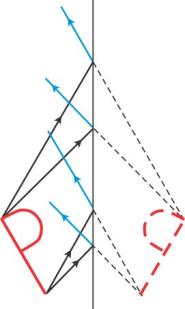
Figure above shows the image formation of a letter P in a plane mirror. The letter P appears in the plane mirror as ![]() .
.
Solution C.7
The letters on the front of a ambulance are written laterally inverted, so that the driver of the vehicle moving ahead of the ambulance reads these words laterally inverted as AMBULANCE, in his rear view mirror, and gices side to pass the ambulance first.
Solution D.1
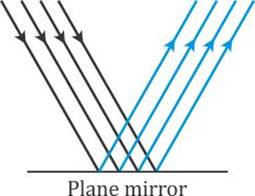
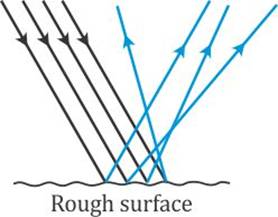
Regular reflection occurs when a beam of light falls on a smooth and polished surface and irregular reflection occurs when a beam of light falls on a rough surface. Since the surface is uneven, from different points light rays get reflected in different directions and give rise to irregular reflection.
Solution D.2
When a light ray strikes a plane mirror, the light ray reflects off the mirror.
Reflection involves a change in direction of the light ray.
The angle of incidence is the angle between this normal line and the incident ray.
The angle of reflection is the angle between this normal line and the reflected ray.
According to the law of reflection,
• the angle of incidence equals the angle of reflection.
• the incident ray, reflected ray and the normal at the point of incidence lie in the same plane.

Experiment
Aim: - To prove the law of reflection through a plane mirror.
Apparatus: - Soft board, white sheet of paper, optical pins, mirror, pencil, protractor and ruler.
Procedure: -
Place the paper on the board and fix
1. Place the mirror vertically on the white sheet of paper and trace its edge.
2. Draw a line at right angles to the edge of the edge of the mirror to act as the normal- ON.
3. Stating with angle i as 30°, draw an incident ray and place two pins, P and Q along it as shown
4. With your eyes at position shown, place two other pins R and S to coincide with the images of P and Q as seen in the mirror
5. Remove pins R and S and join the dots left with a straight line
6. Measure and record angle r.
7. Repeat procedure 4,5,6 and 7 for angles i = 35°, 40°, 45°, 50° and 55°.
8. Record the results in a table.
Observation: -
1. The angle of incidence equals the angle of reflection.
2. Incident ray, reflected ray and the normal at the point of incidence lie in the same plane.
Hence the laws of reflection proved.
Solution D.3
(a) Angle of incidence = 90o - 30o = 60o
(b) Angle between the incident ray and reflected ray = Angle of incidence + Angle of reflection
Angle of reflection = Angle of incidence = 60o
Therefore, Angle between the incident ray and reflected ray = 60o + 60o = 120o
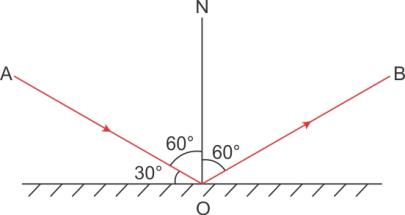
Solution D.4
(a) and (b)
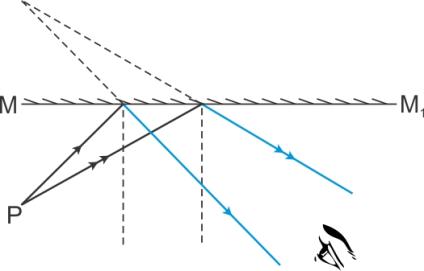
(c) The image formed is virtual because the reflected rays meet when produced backwards.
Solution D.5
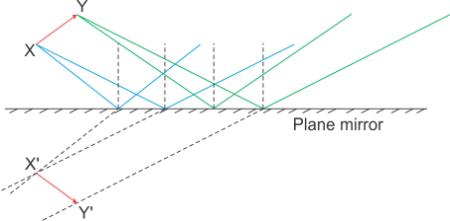
Solution E.1
Angle of incidence (i) + Angle of reflection(r) = 90o
But, as per the laws of reflection, i = r
Therefore, 2 i = 90o
Or, i = r = 45o
Solution E.2
Distance between man and his image = 6m
Distance between man and mirror + distance between mirror and image = 6m
But, Distance between man and mirror (object distance) = distance between mirror and image (image distance)
Therefore, distance of man from mirror = 6/2 = 3m
Solution E.3
(a) Image of the insect is formed 1m behind the mirror.
(b) Distance between the insect and his image = 1 + 1 = 2 m
Solution E.4
Initially, distance of the object from the mirror = 60 cm.
Therefore, image is formed at a distance 60 cm from the mirror, behind it.
Thus, initial distance between the object and image = 60 + 60 = 120 cm
If the mirror is moved 25 cm away from the object,
The new distance of the object from the mirror = 60 + 25 = 85 cm
The new image is now at a distance 85 cm from the mirror behind it.
Thus, new distance of the image from the object = 85 + 85 = 170 cm
Taking the position of the object as reference point, the distance between the two positions of the image = new distance of image from the object - initial distance of the image from the object
= (170 - 120) cm = 50 cm
Thus, the image shifts 50 cm away.
Solution E.5
Distance between man and chart = 3m
Distance between man and mirror = 2m
Therefore, distance between chart and mirror = 5 m
Now, final image is formed on the mirror, which is at a distance of 2 m from the man, therefore, the chart as seen by patient is (5m + 2m =) 7m away.
Reflection of Light Exercise Ex 7(B)
Solution A.1
(d) n
Solution A.2
(c) n - 1
Solution A.3
(c) 5
Solution A.4
(b) Parallel to each other
In a barber's shop, two plane mirrors are placed parallel to each other.
Solution A.5
(d) infinity
Solution A.6
(c) 3
Given that,
θ = 90°
Now,
![]()
Solution A.7
(b) second image
Multiple images are formed in a thick plane mirror due to reflection from both surfaces, with the second image, formed by the silvered surface, being the brightest.
Note:
If the front surface is silvered, only one image will be formed.
Solution A.8
(a) 2 and 3 respectively
Solution A.9
(c) 60°
Solution A.10
(c) 45°
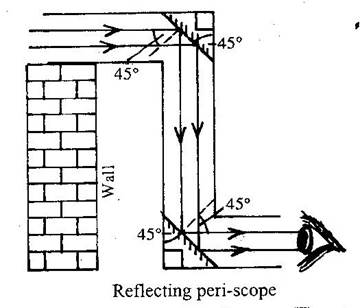
Solution B.1
One of the most common uses of plane mirror is looking glass.
Solution B.2
In the optician's room to increase the effective length of the room by keeping a plane mirror on the front wall and the sign board on the opposite wall behind the patient.
For the patient, the sign board is at double the length of the room.
Solution B.3
The images lie on the circumference of a circle whose no centre lies at the point of intersection of the two mirrors and whose radius is equal to the distance of the object from the point of intersection.
Solution C.1
If two mirrors make an angle θ with each other and object is placed in between the two mirrors, the number of images formed is n or (n - 1) depending upon n = 360o/θ° is odd or even.
(a) If n = 360o/θ° is odd,
(i) The number of images formed is n, when the object is placed asymmetrically between the mirrors.
(ii) The number of images formed is n-1, when the object is placed symmetrically between the mirrors.
(b) If n = 360o/θ° is even, the number of images is always n-1.
Solution C.2
The number of images formed is given as
![]()
So, if q is gradually increased, n decreases.
Solution C.3
Two uses of plane mirror:
1. In barber's shop for seeing the hairs at the back of head, two mirrors facing each other are fixed on opposite walls at the front and back of the viewer.
2. In solar heating devices such as a solar cooker, solar water heater, etc., a plane mirror is used to reflect the incident light rays from sun on the substance to be heated.
Solution D.1
For two mirrors kept perpendicular to each other, three images are formed for an object kept in between them.
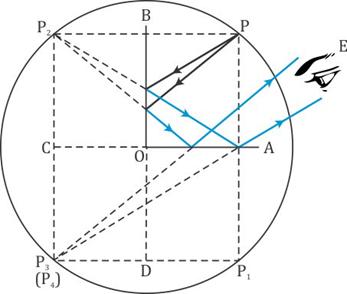
Solution D.2
For two mirrors kept parallel to each other, an infinite number of images are formed for an object kept in between them.
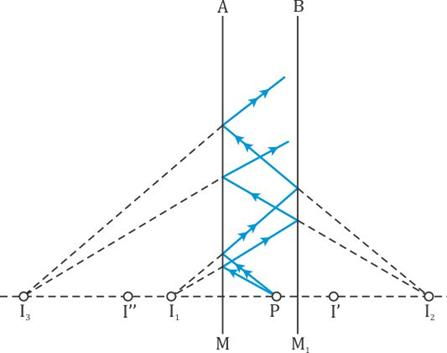
Solution 1 (Num)
(a) Angle between the mirrors, ![]() = 90o
= 90o
Now, n = 360o / ![]() o = 360o / 90o = 4, which is even.
o = 360o / 90o = 4, which is even.
Hence number of images formed will be (n-1); i.e., 4-1 = 3 images
(b) Angle between the mirrors, ![]() = 60o
= 60o
Now, n = 360o / ![]() o = 360o / 60o = 6, which is even.
o = 360o / 60o = 6, which is even.
Hence number of images formed will be (n-1); i.e., 6-1 = 5 images
Solution 2 (Num)
Angle between the mirrors, ![]() = 50o
= 50o
Now, n = 360o / ![]() o = 360o / 50o = 7.2
o = 360o / 50o = 7.2 ![]() 7, which is odd.
7, which is odd.
(i) When placed asymmetrically, number of images formed will be n, i.e. 7.
(ii) When placed symmetrically, number of images formed will be (n-1); i.e. 7-1 = 6 images
Reflection of Light Exercise Ex 7(C)
Solution A.1
(c) hollow glass sphere
Solution A.2
(c) concave, outer
Solution A.3
(b) convex, inner
Solution A.4
(a) (i)
Solution A.5
(b) principal axis, parallel
Solution A.6
(b) real, virtual
Solution A.7
(c) normal
Solution A.8
(a) Retraces its path
Solution A.9
(b) becomes parallel to the principal axis
Solution A.10
(d) real, inverted, diminished to a point
Solution A.11
(d) at centre of curvature, real, same size as
Solution A.12
(b) highly magnified
Solution A.13
(a) Erect and diminished
Solution A.14
(d) virtual, upright and diminished
Solution A.15
(b) half of
The focal length of a spherical mirror is equal to half of its radius of curvature.
i.e., focal length = ½ × Radius of curvature.
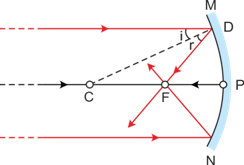
Solution A.16
(a) (i)
Solution A.17
(d) negative, positive
Solution A.18
(c) Concave mirror
Solution A.19
(b) convex mirror
Solution A.20
(c) concave mirror
Solution A.21
(b) convex mirror
Solution B.1
A reflecting surface which is a part of a sphere is called a spherical mirror.
Solution B.2
The centre of curvature of a mirror is the centre of the sphere of which the mirror is a part.
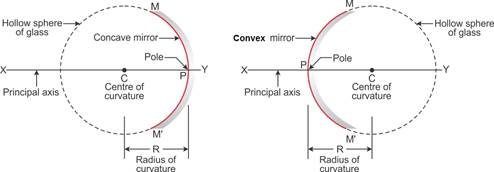
Solution B.3
The radius of a sphere of which the spherical mirror is a part, is called the radius of curvature of the mirror.
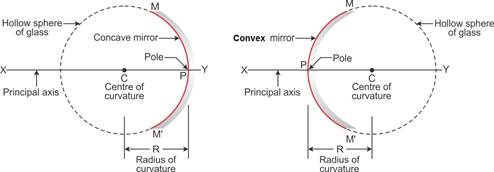
Solution B.4
The plane surface area of the mirror through which light ray enters and fall on the mirror is called its aperture.
Solution B.5
The geometric centre of the spherical surface of mirror is called the pole of mirror.
Solution B.6
Convex mirror always produces erect and virtual images. The images formed are diminished, i.e. the size of the image is shorter than the size of the object.
Solution B.7
(a) If the object is placed between the pole and focus of a concave mirror, the image formed is magnified and erect.
(b) The image is virtual.
Solution B.8
(a) If the object is placed at the centre of curvature of a concave mirror, the image formed is of same size.
(b) The image formed is real and inverted.
Solution B.9
(a) An image which can be obtained on a screen is called a real image.
(b) A concave mirror can be used to obtain a real image of an object.
(c) No, it does not form real image for all locations of the object.
Solution B.10
(a) Concave, (b) Concave, (c) Convex and (d) Concave
Solution B.11
Focal length is half the radius of curvature of a spherical mirror.
![]()
Solution B.12
The spherical mirror's formula is
![]()
Here, u is the object distance, v is the image distance and f is the focal length of the mirror.
Solution B.13
(a) Concave mirror
(b) Concave mirror
Solution B.14
A convex mirror is preferred as a rear view mirror because it has a wider field of view as compared to a plane mirror of same size.
Solution B.15
Linear magnification is defined as the ratio of image distance (v) to object distance (u).
Magnification, ![]()
∴ m = -v/u
Solution C.1
Two kinds of spherical mirrors are concave and convex.
Distinction between concave and convex mirror: A concave mirror's bulging surface is silvered and reflection takes place from the hollow surface but a convex mirror's inner surface is silvered and reflection takes place from the bulging surface.
Solution C.2
Pole: The geometric centre of the spherical surface of mirror is called the pole of mirror.
Principal axis: It is the straight line joining the pole of the mirror to its centre of curvature.
Centre of curvature: The centre of curvature of a mirror is the centre of the sphere of which the mirror is a part.
Solution C.3
(i) Convex mirror diverges a beam of light falling on it.
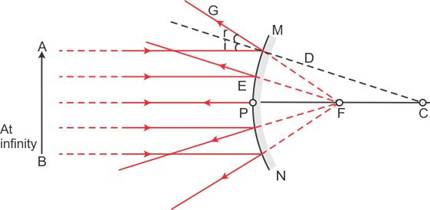
(ii) Concave mirror converges a beam of light falling on it.
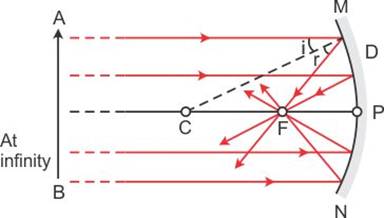
Solution C.4
Focus of a concave mirror: The focus of a concave mirror is a point on the principal axis through which the light rays incident parallel to principal axis, pass after reflection from the mirror.
Focal length of a concave mirror: The distance of the focus from the pole of the concave mirror is called its focal length.
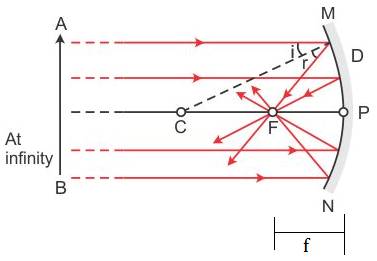
Solution C.5
Incident ray is directed towards the centre of curvature because the ray is normal to the spherical mirror, so ![]() i =
i = ![]() r = O.
r = O.
Solution C.6
Magnification is the ratio of the length of image to the length of the object.
![]()
It is also given as
![]()
Where, u and v is the object and image distance, respectively.
Hence, we have
a. For real image: u and v are negative. So, m is negative.
b. For virtual image: u is negative and v is positive. So, m is positive.
Solution C.7
The image formed by a convex mirror is always between pole and focus. Hence, the maximum distance that can be obtained in convex mirror is the focal length. For this case the object has to be at infinity.
Solution C.8
The maximum distance that can be obtained in concave mirror is infinity. For this case the object has to be at focus.
Solution C.9
To distinguish between a plane mirror, concave mirror and convex mirror, the given mirror is held near the face and image is seen. There can be following three cases:
Case (i): If the image is upright, of same size and it does not change in size by moving the mirror towards or away from the face, the mirror is plane.
(ii) If the image is upright and magnified, and increases in size on moving the mirror away, the mirror is concave.
(iii) If the image is upright and diminished and decreases in size on moving the mirror away, the mirror is convex.
Solution C.10
Two uses of concave mirror:
(i) It is used as a shaving mirror.
(ii) It is used as reflector in torch, head light of automobiles etc.
Solution C.11
(a) The person's face is between the pole and focus of the mirror.
(b) The image formed is erect, virtual and magnified.
Solution D.1
(i)

(ii)

Solution D.2
Focus of a convex mirror: The focus of a convex mirror is a point on the principal axis from which, the light rays incident parallel to principal axis, appear to come, after reflection from the mirror.
Focal length of a convex mirror: The distance of the focus from the pole of the convex mirror is called its focal length.
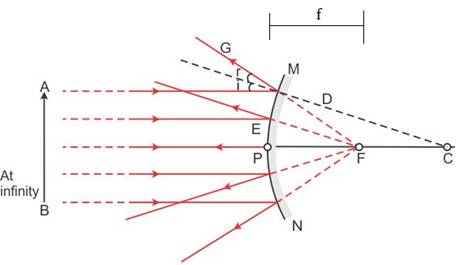
Solution D.3
(i) In figure (a) a convex mirror is shown.
In figure (b) a concave mirror is shown. (ii) (a)

(b)
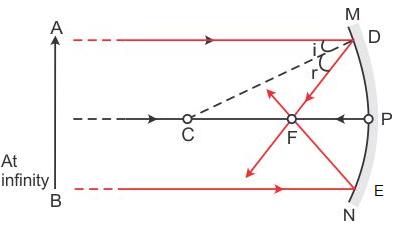
Solution D.4
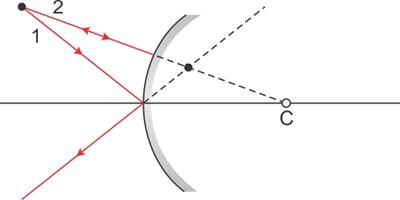
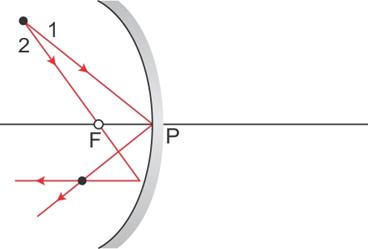
Solution D.5
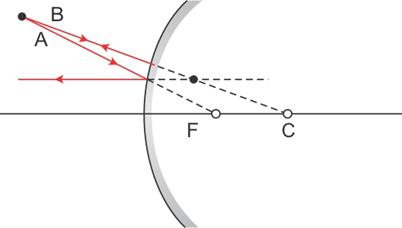
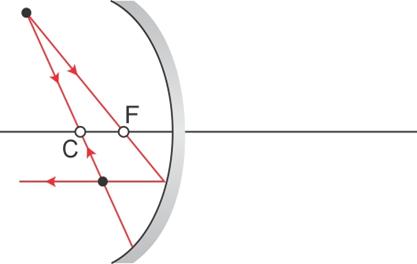
Solution D.6
Two convenient rays that are chosen to construct the image by a spherical mirror for a given object:
1. A ray passing through the centre of curvature: A ray of light passing through the centre of curvature of a concave mirror or a ray directed in the direction of centre of curvature of a convex mirror is reflected back along the same path after reflection.
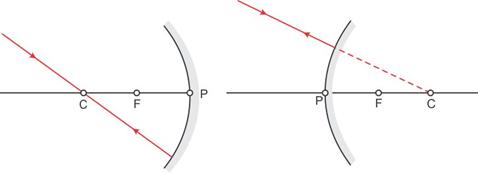
2. A ray parallel to the principal axis: A ray of light parallel to the principal axis, after reflection pass through the principal focus in case of a concave mirror or appears to diverge from it in case of convex mirror.
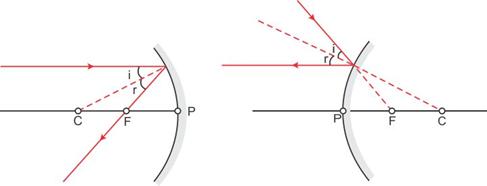
Solution D.7
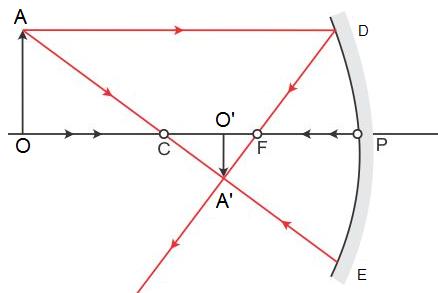
Solution D.8
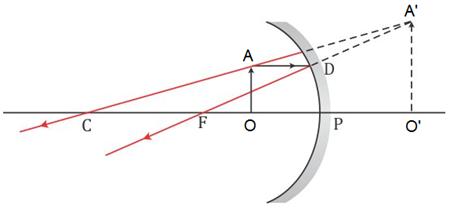
Solution D.9
The ray diagram shows two light rays from A.
The image of the object OA is formed between the focus and the pole on the other side of the mirror.
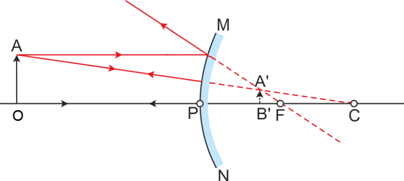
The image so formed is erect, virtual and diminished.
Solution D.10
Ray diagram showing the formation of an image by a concave mirror for an object placed between its pole and focus:
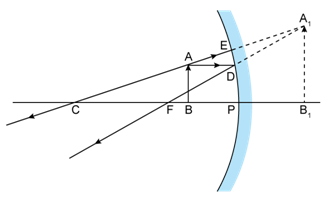
When the object is placed between focus F and pole P, the image is formed behind the mirror.
The image so formed is virtual, upright and magnified.
Solution D.11
Ray diagram showing the formation of an image by a concave mirror for the object beyond its centre of curvature:
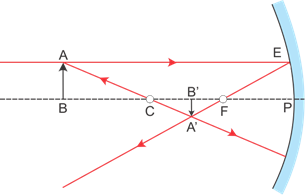
When the object is placed beyond the centre of curvature C, the image is formed between focus F and centre of curvature C. The image so formed is real, inverted and diminished.
Solution D.12
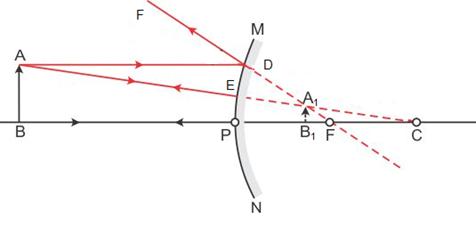
The image formed is virtual, erect and diminished.
Solution D.13
When an object is moved from infinity towards the pole of mirror, the image formed moves away from the mirror. The image formed is real and inverted.
Solution D.14
In a convex mirror, the image formed is always virtual, upright and diminished. It is always situated between its pole and focus, irrespective of the distance of object in front of the mirror.
Solution D.15
A convex mirror diverges the incident beam and always forms a virtual, small and erect image between its pole and focus. Thus, a driver can see all the traffic approaching from behind. This fact enables the driver to use it as a rear view in vehicles to see all the traffic approaching from behind.
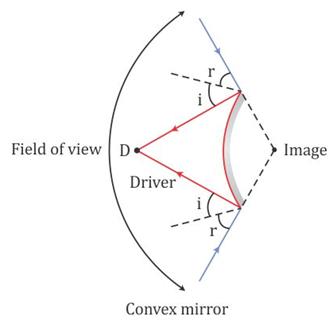
Solution E.1
Focal length = ½ (Radius of curvature)
Or, f = 40/2 = 20 cm
Solution E.2
Radius of curvature = 2 ![]() focal length
focal length
Or, R = 2f = 2 ![]() 10 = 20 cm
10 = 20 cm
Solution E.3

The image is 30 cm in front of the mirror, 3 cm high, real, inverted and magnified.
Solution E.4
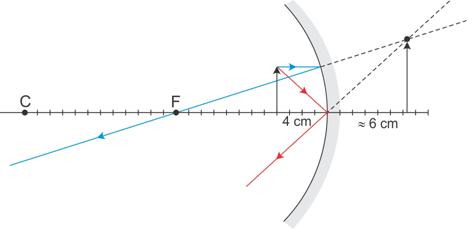
The image is 6 cm behind the mirror.
Yes the image is magnified.
Solution E.5
The size of the image is equal to the size of the object if the object is placed at the centre of curvature of a concave mirror.
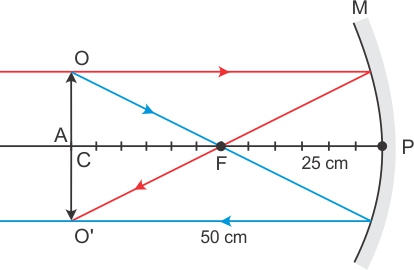
Hence, the object should be placed at 50 cm.
Solution E.6

The position of the object is 12 cm in front of the mirror.
Its size is 1 cm.
Solution E.7
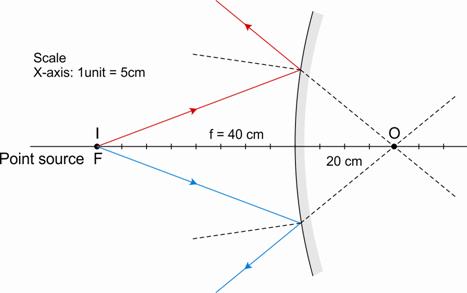
The image is behind the mirror at a distance 20 cm.
Solution E.8
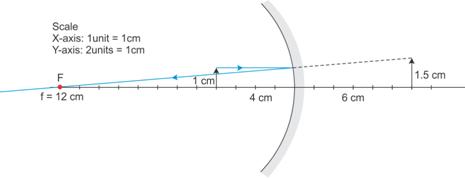
A ray passing parallel to the principal axis passes through the focal point after reflection. Hence, the focal length is 12 cm.
Solution E.9
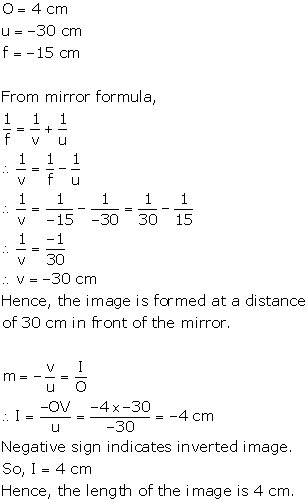
Solution E.10
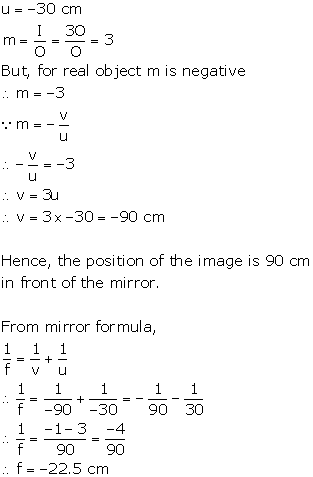
Solution E.11

Solution E.12
Magnification is

A convex mirror always forms a virtual and an upright image. So,

Solution E.13
Magnification is
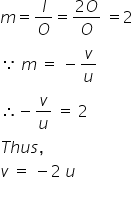
Solution E.14
The magnification of a mirror is
